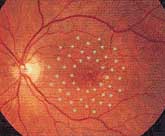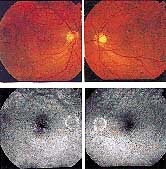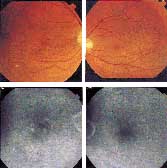Study suggests a prophylactic treatment for CNV
A recently completed 4-year study has shown that a grid infrared diode laser treatment can delay the progression of dry AMD to wet AMD.
Click Here to Manage Email Alerts
 ---Treatment that was
applied in a 48-spot macular grid pattern.
---Treatment that was
applied in a 48-spot macular grid pattern.
FORT LAUDERDALE, U.S.A. — The results of a 4-year study are now suggesting that a grid infrared (810 nm) diode laser treatment was able to reduce the incidence of progression from dry age-related macular degeneration (AMD) to wet AMD.
R. Joseph Olk, MD, presented his results during the Association for Research in Vision and Ophthalmology. The study included 229 eyes of 152 patients with dry AMD and was conducted at four U.S. clinical centers. The patients were randomized to receive treatment by the Iridex (Mountain View, U.S.A.) OcuLight SLx infrared laser photocoagulator or be observed in a control group.
Dr. Olk and his participating colleagues in the study believe that that the 810 nm diode laser was the correct wavelength to treat the disease at the retinal pigment epithelium level and Bruch’s membrane. Dr. Olk said he believes the treatment translates into a reduction in the development of choroidal neovascularization (CNV).
Study parameters
|
The results he presented are of his pilot trial of 152 patients and 229 eyes. The study consisted of 63 eyes that were treated with visible burns, 57 eyes that were treated with subthreshold burns and 109 control group eyes.
To be entered into the study, patients had to be suffering from dry AMD, have five or more large, soft drusen deposits and a visual acuity better than 20/63.
Each of the eyes in the study received a one-time 48-spot grid treatment on their retina. The grid consisted of 125-µm spots and covered a region 0.5 to 1.5 disk diameters from the fovea. The visible and subthreshold burns were delivered similarly from the nasal retina. The only difference was that the visible burn consisted of a 200-msec pulse duration versus the subthreshold’s 100-msec pulse duration.
At the 4-year follow-up visit, drusen levels were reduced more than 50% in almost 80% of the treated eyes. Only 7.5% of the observed eyes saw a reduction in drusen levels. Not all the eyes in the original treatment group were available at the 4-year follow-up.
Visual acuity was improved by two or more lines in 13.5% of the treated eyes. In the end, all of the eyes that showed increased visual acuity had reductions in drusen levels.
While looking at the results, Dr. Olk and his team realized that those eyes that did remain “unwet” saw a significant reduction of drusen in their eyes.
Somewhat surprisingly, only one of the 35 eyes that developed CNV in the 4-year follow-up was from the treated group.
“This shows a dramatic prophylactic effect for these [treated] eyes,” Dr. Olk said.
Hope for better future results
In future studies, Dr. Olk said he believes that re-treatments may help increase the number of eyes with reduced drusen. No re-treatments occurred in this study.
Dr. Olk explained that the reason why some eyes were protected and others continued to deteriorate are likely the results of individual responses to a general single treatment. He suspected that if the treatment is more tailored to each patient’s specific needs, the results may improve. All the treatments were generically administered in this study.
Dr. Olk said it is his belief that the prophylactic effect of the diode treatment can open up a new opportunity for treatment for patients stricken with dry AMD. It is believed that 90% of the AMD patients in the United States have the dry form of AMD.
Both burn methods proved to be nearly equally effective in reducing drusen levels and in improving visual acuity. However, in the future, Dr. Olk believes a subthreshold burn is the best treatment option since it showed no related complications. There were six complications presented with the visible burn technique.
For Your Information:
- R. Joseph Olk, MD, can be reached at The Retina Center of St. Louis County, 11710 Old Ballas Road, Ste. 102, St. Louis, MO 63141 U.S.A.; +(1) 314-569-2020; fax: +(1) 314-569-1596. Dr. Olk has no direct financial interest in any of the products mentioned in this article. He is a paid consultant for Iridex Corporation.
- Iridex Corporation can be reached at 1212 Terra Bella Ave., Mountain View, CA 94043 U.S.A.; +(1) 650-962-8100; fax: +(1) 650-962-0486; Web site: www.iridex.com.


